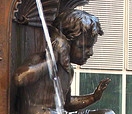 I took a break from editing to visit an exhibition at Pallant House Gallery in Chichester. The illustrator featured was a friend of Eric Ravilious ( who so perfectly captured Downland Sussex ) and had worked on children’s books so I thought I’d give it a go.
I took a break from editing to visit an exhibition at Pallant House Gallery in Chichester. The illustrator featured was a friend of Eric Ravilious ( who so perfectly captured Downland Sussex ) and had worked on children’s books so I thought I’d give it a go.
Enid Marx (1902 – 1998) was the first woman engraver to be appointed a Royal Designer for Industry in 1944 amongst other claims to fame. Do look her up – she is quite inspiring. But I want to focus on what I saw – and what it said to me as a writer.
It was lovely to see a real book, slightly worn and read, on display. Her designs for Zodiac Books’ ‘Nursery Rhymes’ were light-hearted, slightly scribbly and full of tiny details. She hid ‘easter eggs’ to spot – a technique which appeals directly to children. An early form of interactivity, you might say.
It was also plain she did not patronise children. The birds for Who Killed Cock Robin are each recognisable, the seaweeds in a cloth-book are identifiable and the herring gull and tern quite distinct. She gave her animals character (her cats are particularly fine) but they are not twee. Her large owl is definitely predatory, if not haunting.
I should not have been surprised that she and her partner Margaret Lambert studied and wrote about English traditional art. There is that same directness, delight in detail and playfulness. Despite her sophisticated technical ability, she strove to create something engaging and apparently simple.
That was the message for me. I believe that open-minded children are not so easily fooled by the smooth and glibly perfect, that they react to the quirky, the wonky but honest, and loathe being talked down to. It is our job to produce the best we can, using all our adult guile – yet remain true to our stories.





